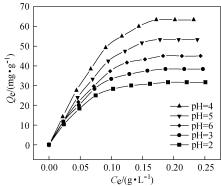化学学报 ›› 2011, Vol. 69 ›› Issue (14): 1705-1714. 上一篇 下一篇
研究论文
陈迎鑫,高保娇*,姜桂明,张瑞霞
CHEN Ying-Xin, GAO Bao-Jiao, JIANG Gui-Ming, ZHANG Rui-Xia

通过γ-(甲基丙烯酰氧)丙基三甲氧基硅烷的媒介, 在溶液聚合体系中, 采用“接出”(“graft from”)法将功能单体甲基丙烯酸二甲基氨基乙酯(DMAEMA)接枝于硅胶微粒表面, 制得了功能接枝微粒PDMAEMA/SiO2, 采用本课题组建立的新型分子表面印迹技术, 以天冬氨酸(Asp)的一种对映体L-Asp为模板分子, 二氯乙醚为交联剂, 对接枝在硅胶表面的大分子PDMAEMA实施了分子印迹, 制备了L-Asp分子表面印迹材料MIP-PDMAEMA/SiO2. 以天冬氨酸的另一种对映体D-Asp为对比物, 采用静态与动态两种方法深入研究了MIP-PDMAEMA/SiO2对L-Asp分子的识别性能, 重点探索了采用分子表面印迹材料对氨基酸对映体进行拆分的可行性. 实验结果表明, 印迹材料MIP-PDMAEMA/SiO2对模板分子L-Asp具有良好的识别选择性与结合亲和性, 相对于D-Asp, 识别选择性系数为3.24, 显示出良好的拆分性能. 此外, 印迹材料MIP-PDMAEMA/SiO2也具有良好的解吸性能, 以稀NaOH水溶液作为洗脱液, 13个床体积内解吸率即可达到99.73%.
中图分类号: